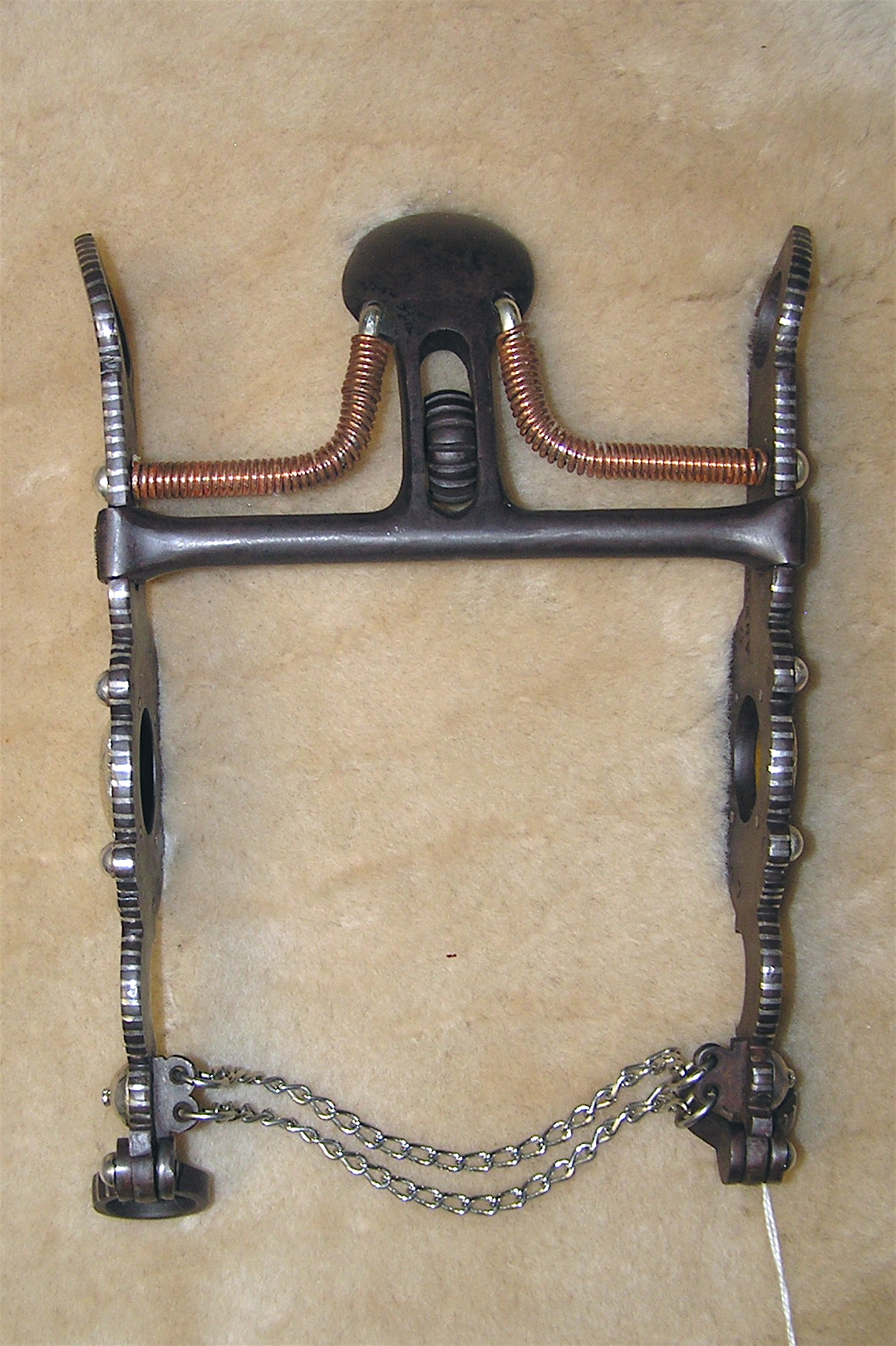Spade bit (horse) on:
[Wikipedia]
[Google]
[Amazon]

 The spade bit is a historic
The spade bit is a historic
 Traditionally, the ''vaquero'' method starts a young horse using a
Traditionally, the ''vaquero'' method starts a young horse using a
Jaheil, Jessica. "Bosal, snaffle, spade - why?" ''Horse Sense,''
web page accessed July 11, 2011 {{Horse equipment Bits (horse)

 The spade bit is a historic
The spade bit is a historic vaquero
The ''vaquero'' (; pt, vaqueiro, , ) is a horse-mounted livestock herder of a tradition that has its roots in the Iberian Peninsula and extensively developed in Mexico from a methodology brought to Latin America from Spain. The vaquero became t ...
design for a type of curb bit
A curb bit is a type of bit used for riding horses that uses lever action. It includes the pelham bit and the Weymouth curb along with the traditional "curb bit" used mainly by Western riders.
Kimblewicks or "Kimberwickes" are modified curb ...
with straight, highly decorated shanks and a mouthpiece that includes a straight bar, a narrow port with a cricket, and a "spoon," a flat, partly rounded plate affixed above the port, supported by braces on either side. Considered a highly technical piece of equipment to be used only on a finished horse, the spade bit is a refined tool that experts compare to driving a sports car in its ability to convey precise commands to the horse. Not all horses have the conformation or temperament to become a finished spade bit horse, a process that takes a number of years and is seldom complete until a horse has at least five years of training under saddle.
Use
The spadebit
The bit is the most basic unit of information in computing and digital communications. The name is a portmanteau of binary digit. The bit represents a logical state with one of two possible values. These values are most commonly represente ...
is an elaborate, complex bit that can only be properly used on a highly trained horse handled by a skilled rider. In the ''vaquero'' tradition, its use represents the highest level of trust and communication between horse and rider.
Experts compare the ride and handling of a horse trained in this manner to that of a Jaguar
The jaguar (''Panthera onca'') is a large cat species and the only living member of the genus '' Panthera'' native to the Americas. With a body length of up to and a weight of up to , it is the largest cat species in the Americas and the th ...
. The process of training the spade bit horse takes five to seven years to complete. Its emphasis has always been on producing a finely tuned working horse and partner, emphasizing quality rather than on how quickly the goal is reached. The conformation of the horse is also a factor; to become a spade bit horse, the animal must be bred to have a higher neck set and well-carried head.
 Traditionally, the ''vaquero'' method starts a young horse using a
Traditionally, the ''vaquero'' method starts a young horse using a hackamore
A hackamore is a type of animal headgear which does not have a bit. Instead, it has a special type of noseband that works on pressure points on the face, nose, and chin. Hackamores are most often seen in western riding and other styles of r ...
, which is headgear with no bit
The bit is the most basic unit of information in computing and digital communications. The name is a portmanteau of binary digit. The bit represents a logical state with one of two possible values. These values are most commonly represente ...
that uses a heavy rawhide noseband, called a bosal
A bosal (, , or ) is a type of noseband used on the classic hackamore of the '' vaquero'' tradition. It is usually made of braided rawhide and is fitted to the horse in a manner that allows it to rest quietly until the rider uses the reins ...
, to control the horse. Then the horse moves to lighter bosals, and next into a combination of headgear that represents a transitional period in its training; a bridle
A bridle is a piece of equipment used to direct a horse. As defined in the ''Oxford English Dictionary'', the "bridle" includes both the that holds a bit that goes in the mouth of a horse, and the reins that are attached to the bit.
Headgear w ...
with a type of curb bit
A curb bit is a type of bit used for riding horses that uses lever action. It includes the pelham bit and the Weymouth curb along with the traditional "curb bit" used mainly by Western riders.
Kimblewicks or "Kimberwickes" are modified curb ...
called a "half breed" which is worn in conjunction with a light bosal. The rider carries two sets of reins, one set on the bosal and one on the curb, giving this gear its name, the "two-rein. After several years in a two-rein, the horse graduates into the spade bit. A light bosal called a bosalito remains on the horse by tradition, usually without reins attached.
References
Sources
* * * *Bennett, Deb (1998) Conquerors: The Roots of New World Horsemanship. Amigo Publications Inc; 1st edition. *Connell, Ed (1952) Hackamore Reinsman. The Longhorn Press, Cisco, Texas. Fifth Printing, August, 1958.Jaheil, Jessica. "Bosal, snaffle, spade - why?" ''Horse Sense,''
web page accessed July 11, 2011 {{Horse equipment Bits (horse)